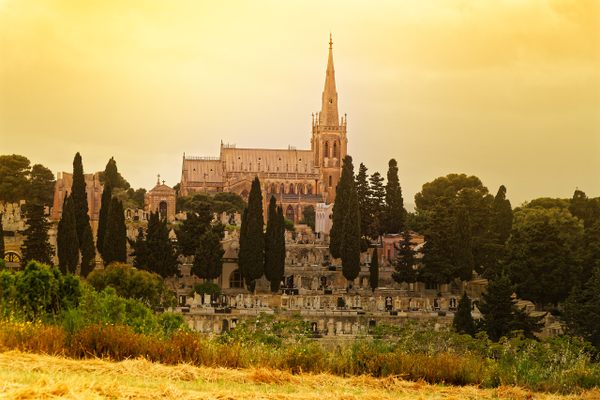During the 19th century, many European nations pursued the construction of opulent cemeteries with elaborate architectural features and multitudes of mausolea. One of the grandest European cemeteries from this period is the Addolorata Cemetery on the island of Malta, which was part of the British Empire during most of the 19th century. This cemetery was designed by Maltese architect Emmanuel Luigi Galizia, and although he designed many other public buildings and cemeteries across the islands of Malta, the Addolarata Cemetery is widely considered to be his masterpiece.
The cemetery is located on a small hill outside the municipality of Paola to the south of the Grand Harbor. Most of the buildings are built in a Neo-Gothic style, and the buildings, the walls of the terraces, and many of the mausolea are made with the beige limestone commonly found throughout the Maltese islands.
The entrance at the north end of the cemetery features an arched gate between two Neo-Gothic buildings (now used for administration). Just inside the gate, the road forks. In between the two roads stands a curved cloistered structure with multiple pointed arches. A central walkway leads through the center of this structure up several terraces covered with grave markers and mausolea to the chapel, which stands at the top of the hill at the center of the cemetery. Other pathways fork off this central path, forming a triangular layout crowded with more grave markers and grand Victorian-era mausolea. Towards the rear, the cemetery follows a grid pattern, and a modern extension has recently been created just west of the cemetery’s south entrance.
The cemetery was opened in 1869 but was not first used until 1872. The tradition in Malta at the time was to bury people within churches; it took time for the local populace to adjust to the idea of using an outdoor burial site. Initially, only people who were Roman Catholic, which was the predominant religion of Malta, could use the cemetery, but in the 1960s and 1970s, changes were made to the cemetery’s rules to permit other people to be buried there. Over 15,500 people are now interred within the cemetery, and while the site has become quite crowded, the extension to the south will help to ensure that Addolorata Cemetery can continue to meet the needs of the people of Malta in the future.
Know Before You Go
Addolorata Cemetery is located just south of Valetta and the Grand Harbour and just west of the municipalities of Paola and Tarxien. Multiple buses frequently travel to the area around the cemetery from Valletta and other locations on the island of Malta. For people driving, parking is available at the north entrance.
The cemetery is generally open from 7 a.m. to 5 p.m., although it closes at 4:30 p.m. on Saturday. The layout of the cemetery makes it easily accessible to people with wheelchairs.
Note that the cemetery is still in active use, so be quiet and respectful when visiting.

